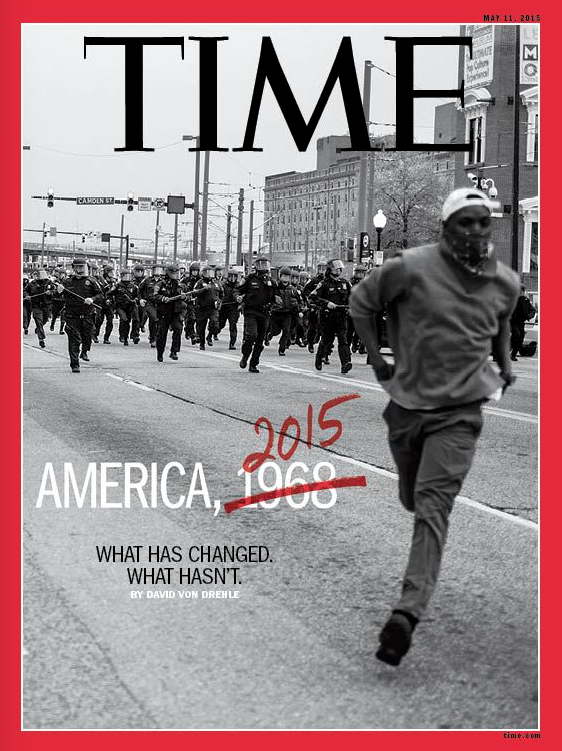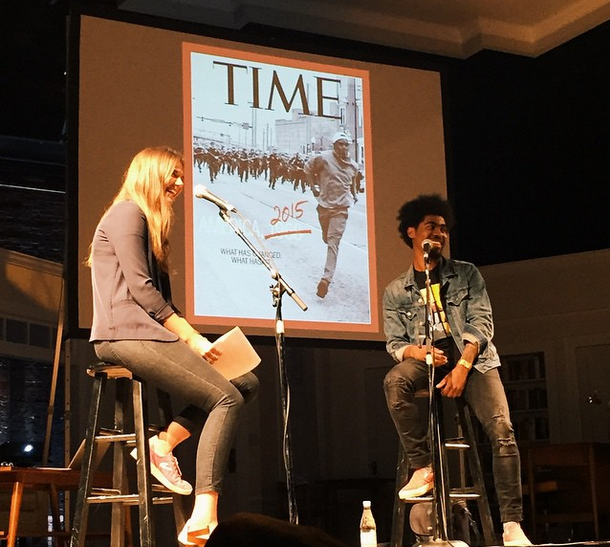News & Community
Creative Mornings with Devin Allen
The 26-year-old photographer talks about the local community and his sudden fame from his Time magazine cover photo.
The theme of this month’s
Creative Mornings talk was supposed to be about robots. Katie Boyts, the organizer of our local chapter, had it all planned out. That was until a couple of weeks ago, when “robot” didn’t feel like the right subject to tackle.
Though Creative Mornings is a national platform for artists—with 112 branches around the country following the same theme at breakfast lectures every month—she decided to switch things up.
“I looked ahead to June and saw that the theme was revolution,” she said in front of an audience at
Center Stage this morning. “That made sense to me for a lot of reasons, mostly just to stay relevant to the community.”
Her other main motivation was to get
Devin Allen on stage. Allen is a 26-year-old photographer from West Baltimore who is self-taught “mostly from YouTube and a lot of trial and error,” he says, whose photograph from the riots on April 25 was published on the cover of Time magazine two weeks ago.
Allen first bought a camera in 2013 and and his predominantly black-and-white photography began with a focus on fashion and street scenes. But after the protests in Ferguson and, subsequently, Baltimore his images veered toward the political.
“We are blinded by a lot of pain around the world,” he says. “And I knew I had to voice that in my art.”
The photographer is quick to point out that, not only was he documenting the unrest in Baltimore from day one, but he himself was peacefully protesting and was able to see what was happening “on both sides.”
“I try to tell the whole story,” he says. “I have my problems with police, but you just can’t profile them all as bad. We need to see police out walking their beat everyday, making a connection with the community.”
Of course, the clash with police and community came to a head just a few weeks ago when 100 rioters, out of the thousands of peaceful protestors, stirred violence near Camden Yards on April 25. And Allen was on the front lines to capture it.

“I was right on the side of the street and my back was turned, but when I turned around, I saw the police coming towards us and I focused on them on purpose,” he says of the
Time cover photo. “I took the shot and said, ‘Damn, this is a good-ass picture’ and then I bent down to send it to my phone and tweeted it out. Next thing I know, police were telling me to move and helped me over the railing to get out of the way.”
The next few hours, and days, were a blur for Allen. Not only was he dealing with caring for family and friends affected by the unrest, but his photograph went viral. He received calls from the BBC, got tweeted by Rihanna, and then
Time magazine reached out.
“I was like, ‘Time magazine…what?!'” he says with shock still in his voice. “At first it was just supposed to be a blog, then a feature spread, then I saw a tweet: ‘Amateur photographer snags cover of Time magazine.’ I just called my mom and we both started crying.”
(Ironically, his mom, like any mother, wanted Allen to come home that Saturday night. “I told her, ‘Aren’t you glad I didn’t come home?'”)
Allen says he still cries every time he sees the cover. “I just want to inspire kids that a leap of faith can change what you want,” he says. “You don’t have to be a rapper or basketball player to make it.”
The cover catapulted Allen to a certain level of fame that he wasn’t necessarily ready for, but he said the entire experience has made him fall in love with Baltimore, a city that he wasn’t always fond of.
“I used to hate being here,” he says. “I wanted to leave and try to get a bigger following. But seeing these protests and this reaction, people here are so strong. It changed my mind.”
Allen used to have dreams of New York City, but says that he is here to stay both for his day job working with autistic and intellectually disabled patients and, of course, to continue to take photographs.
“I want to do gallery shows, teach kids about photography,” he says. “But also I want to keep the pot stirring here; I don’t want anything to settle. It’s right to follow through on that.”
Allen says his main mission through his photographs is to show people that stories are not one-sided. In fact, the photo he wishes made the cover of
Time? One of a policeman crying listening to Freddie Gray’s family speak.
“I think that could have swayed a lot of point of views.”
